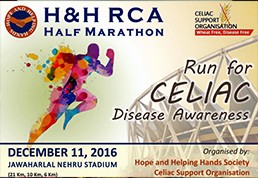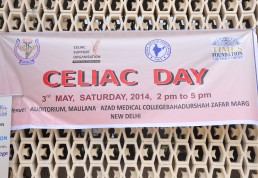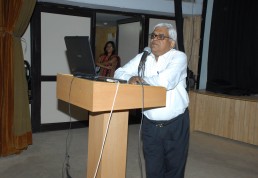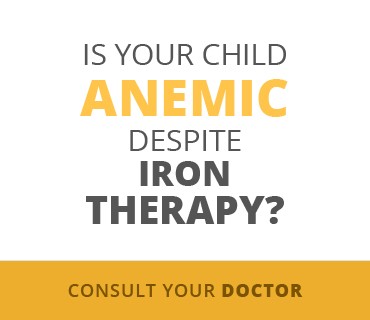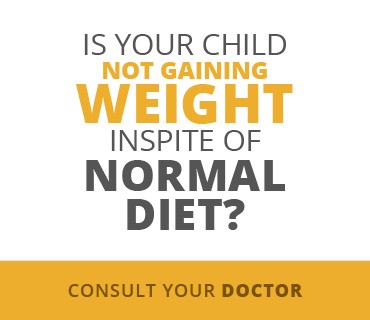Your child has been diagnosed with a disease called Celiac disease (CD). Even though you may not accept it today, it is really fortunate that of all diseases, it is CD because it is an eminently manageable disease, if not completely curable.
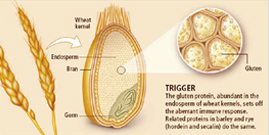 Cause : This disease occurs due to an allergy to a protein called gluten present in wheat. This is the substance which makes wheat dough very soft and pliable. Gluten triggers an autoimmune response in the body, the gluten molecule is actually attacked by the body so as to eliminate it, but in the process the normal cells also get affected and get damaged.
Cause : This disease occurs due to an allergy to a protein called gluten present in wheat. This is the substance which makes wheat dough very soft and pliable. Gluten triggers an autoimmune response in the body, the gluten molecule is actually attacked by the body so as to eliminate it, but in the process the normal cells also get affected and get damaged.
The intestine is therefore not able to absorb foods leading to chronic diarrhea and to deficiency of various nutrients in the body.
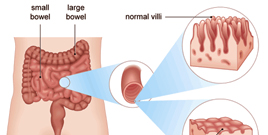 Genetics : There is a genetic basis to this disease. Some children may be predisposed to this disease by birth. There is a high chance among the siblings of the patient to also manifest the disease. Therefore sibling screening is always advisable and if CD is diagnosed well in time, the manifestations of disease can be prevented and reversed by completely
Genetics : There is a genetic basis to this disease. Some children may be predisposed to this disease by birth. There is a high chance among the siblings of the patient to also manifest the disease. Therefore sibling screening is always advisable and if CD is diagnosed well in time, the manifestations of disease can be prevented and reversed by completely
avoiding all sources of gluten in diet and instead to take adequate nutrition from gluten free foods. Adherence to these gluten free foods has not only to be total but also lifelong. Celiac disease is a rare disease in that the disease does not require any specific medicine except strict avoidance of wheat.
Help from an expert nutritionist would be required to plan an age appropriate gluten free diet from home available foods and also to avoid foods with hidden gluten (most of the fast foods, sauces, ice creams, some medicinal tonics etc may contain gluten in varying amounts). It is well to remember that even miniscule amounts of gluten can be as harmful as eating a whole chappati.
Generally in the Indian diets, solids are introduced to a baby typically at the age of 6-8 months. Usually the baby continues to breast feed along with complementary feeding. If the child has Celiac disease, he may manifest the symptoms early as 8-9 months or she may become symptomatic much later say at the age of 4-5 years or even at adolescence. The disease may latent or silent even up to 40 years.
Clinical Presentation
Typical
Atypical Presentations
- Bone/joint pains
- Frequent oral ulcers
- Dental defects and dysplasias
- Multiple vitamin and mineral deficiencies
- Headaches
- Ataxia
- Delayed puberty, delayed menarche, infertility
- Nosebleeds
- Muscle cramps
- Hair loss
- Skin lesions
- Auto immune diseases such as thyroiditis, juvenile diabetes mellitus
These symptoms make the patients /parents run from pillar to post, in search of relief for the child. There may be gap of even 4-5 years before the disease is diagnosed. Celiac disease is one of the most frequently missed diseases according to Readers Digest. For every one case diagnosed, 140 go undiagnosed.
Why the diagnosis is missed
- Parents often don’t have time to visit the doctor
- Parents often believe that this “feeling unwell” is a phase and will pass
- Disease is very mild or almost asymptomatic or atypical
- Anemia, short stature is very common, often taken as a minor problem
- Routine lab tests don’t show up this disease
- Many doctors are not well informed and are not aware that this disease is so common
- Doctors often think that the patient is exaggerating the symptoms as irritability, abdominal pain and bone pain (interpreted as growing pains) are so common.
- The initial serological test is costly
- Endoscopy facilities, backed by good pathology are not cheap.
- Sibling screening is not emphasized enough
- Some patients are truly asymptomatic.
Getting Tested: Serology and Biopsy
Serology Blood tests/Serological tests are the most useful tools to look for antibodies being produced in a patient’s body due to wheat intake. The most common tests are
Anti tTG IgA (Anti tissue transglutaminase IgA )
EMA IgA ( Anti Endomysial antibodies IgA
Total serum IgA (Serum immunoglobulin A) ( to be tested if previous two tests are neg)
Biopsy Often misguided parents may get only the blood tests done and not duodenal biopsy. Diagnosis of celiac disease can only be suspected by the blood tests. It must be confirmed by an upper Gastro-Intestinal (GI) endoscopy and biopsy because the stoppage of wheat is for entire life and it is very unfair to deprive the child of wheat unless the diagnosis is absolutely confirmed.
Step wise Treatment of Celiac disease
1. How to stop wheat
We all know that wheat is a staple and dominant part of Indian, particularly North Indian diet. Reducing wheat intake partially from the diet may still be possible but to eliminate wheat completely from the diet is not an easy task. It is tough to stay motivated and give up the favourite foods.
2. Factors facilitating stoppage of wheat
- Accepting that wheat is indeed the cause of the disease and complete stoppage is the only remedy available as of today.
- Even traces of wheat in the food may be unacceptable.
- Social life of the patient is definitely compromised at least for a first few months till the patients and the parents learn to deal with the situation.
- Excessive discussion with the family members should be avoided as each person has emphatic ideas about diet which may be wholly wrong or unfounded.
- All flours should ideally be prepared at home to avoid contamination.
- The concept of gluten free kitchen is ideal where there is no wheat or wheat containing items. All utensils are separate. Meeting families and people with celiac disease often gives courage and ideas as to how to go about managing the disease.
- Variety is the spice of life. Do not let the gluten free diet become boring or repetitive.
3. Treatment of infection
The children with CD often get picked up only when they visit the doctor for some inter- current infection. The immunity is often compromised and child may need antibiotics for treating the infection.
4. Supplements
A child with CD is usually a nutritionally deprived child. Despite adequate intake the child is unable to absorb the nutrients and develops signs and symptoms of nutritional deficiency such as rickets, angular stomatitis, skin lesions due to zinc deficiency and severe anemia as the absorption of iron is seriously compromised.
Prolonged administration of these supplements along with stoppage of wheat causes the gut to heal rapidly and the stores of these nutrients get replenished.
4. Stepwise counseling
- Breaking the news to parents.
- Accepting the diagnosis.
- Understanding the disease and its implications.
- Professional Dietary counselling/dietary choices.
- Frequent follow up for first six months.
- Growth and weight monitoring.
- Management of deficiencies of nutrients induced by malabsorption.
- Management of associated conditions such as hypothyroidism, juvenile Diabetes Mellitus, skin conditions etc.
- Celebrating recovery.
- Coping with psychological and social stresses.
 Cause : This disease occurs due to an allergy to a protein called gluten present in wheat. This is the substance which makes wheat dough very soft and pliable. Gluten triggers an autoimmune response in the body, the gluten molecule is actually attacked by the body so as to eliminate it, but in the process the normal cells also get affected and get damaged.
Cause : This disease occurs due to an allergy to a protein called gluten present in wheat. This is the substance which makes wheat dough very soft and pliable. Gluten triggers an autoimmune response in the body, the gluten molecule is actually attacked by the body so as to eliminate it, but in the process the normal cells also get affected and get damaged.  Genetics : There is a genetic basis to this disease. Some children may be predisposed to this disease by birth. There is a high chance among the siblings of the patient to also manifest the disease. Therefore sibling screening is always advisable and if CD is diagnosed well in time, the manifestations of disease can be prevented and reversed by completely
Genetics : There is a genetic basis to this disease. Some children may be predisposed to this disease by birth. There is a high chance among the siblings of the patient to also manifest the disease. Therefore sibling screening is always advisable and if CD is diagnosed well in time, the manifestations of disease can be prevented and reversed by completely

